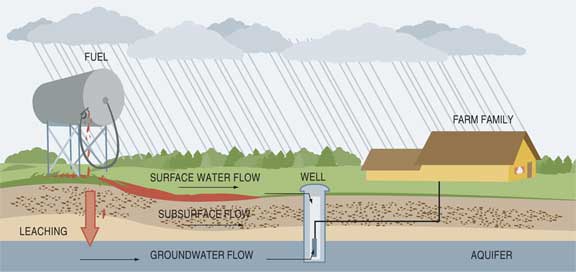| |
Farm Fuel Storage and Handling - Why is Farm Fuel Storage and Handling Such an Important Issue? | |
| |
|
|
| |
|
|
| | The capacity of diesel and gasoline storage on Alberta farms is at least 250 million litres (55 million gallons). This large volume of stored fuel poses great financial, environmental and public liability risks to farmers. This publication provides information to help farmers store and use gasoline and diesel fuel.

Figure 1: Fuel storage as a possible source of contamination
Traditionally, fuel storage on farms in Alberta consisted of overhead, gravity fed tanks (as shown above in Figure 1). Although these types of systems are still very common on today’s farms, there are now other options available to producers in Alberta. The traditional gravity type systems are being replaced with systems that reduce the risk of fire, spills and leaks, and help to avoid contamination, evaporation, deterioration and theft.
Environmental Implications
It is the responsibility of all Albertans to ensure the protection, enhancement and wise use of the environment. No person is allowed or permitted to release a substance in an amount, concentration level or at a rate that causes or may cause a significant adverse effect.
Poor management of fuel storage tanks can lead to environmental impacts on soil and groundwater and health and safety issues. It only takes a few litres of gasoline to severely pollute a farmstead’s drinking water supply. A small leak of one drop per second can release about 900 litres (200 gallons) of gasoline into the groundwater in one year.
Financial Implications
Practicing “due diligence” is also a major part of protecting the ability to borrow money or obtain insurance. Banks, lending agencies and insurance companies recognize the risks of farm fuel storage and handling. Potential risks of environmental damage may be enough to prevent loan approval or insurance coverage.
Source: Agdex 769-1. September 2008. |
|
| |
|
|
| |
Other Documents in the Series |
|
| |
Farm Fuel Storage and Handling
Farm Fuel Storage and Handling - Why is Farm Fuel Storage and Handling Such an Important Issue? - Current Document
Farm Fuel Storage and Handling - What can You do?
Farm Fuel Storage and Handling - What is the Legislation Regarding Farm Fuel Storage?
Farm Fuel Storage and Handling - What are the Risks?
Farm Fuel Storage and Handling - What are Other Common Issues With on Farm Fuel Storage?
Farm Fuel Storage and Handling - What Types of Fuel Storage Systems are Available?
Farm Fuel Storage and Handling - Planning Your Fuel Storage Site - What You Need to Know
Farm Fuel Storage and Handling - What do You do With the Old Tanks?
Farm Fuel Storage and Handling - Emergency Procedures
Farm Fuel Storage and Handling - Are There Special Considerations for Storing and Handling Biofuels?
Farm Fuel Storage and Handling - Appendix: Frequently asked questions
Farm Fuel Storage and Handling - Appendix: Emergency Plan and Spill Kits
Farm Fuel Storage and Handling - Appendix: Monitoring for Fuel Losses and Fuel Inventory Sheet
Farm Fuel Storage and Handling - Appendix: For More Information
Farm Fuel Storage and Handling - Appendix: Glossary and Acronyms
|
|
| |
|
|
| |
For more information about the content of this document, contact Melissa Orr-Langner.
This document is maintained by Jennifer Rutter.
This information published to the web on September 25, 2008.
|
|